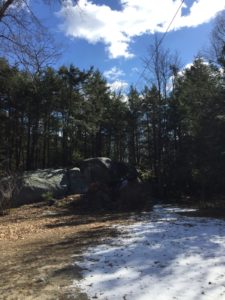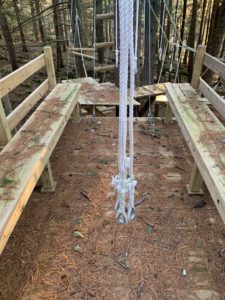Time to Wake Up Your Challenge Course!
From: Todd Brown & Ian Doak

Here in New England, it is not often that the first day of spring and the view out my window match up and today is no different—pockets of snow on the ground and blustery wind swirling about!
Spring has a special meaning for Challenge Course managers in the Northern regions: it’s time to wake up your course from its winter slumber. It’s that time when you take a walk through the woods and see what surprises—good or bad—are in store for you after winter storms have dropped limbs and whole trees along with the snow. While, in light of the ongoing impacts of COVID-19, your organization’s summer plans may not yet be clear, spring cleanup and performing any needed maintenance of your challenge course are essential to safe course operation.
Here’s a list of things to put onto your spring-cleaning ‘To Do’ list that will help to make sure you’re ready to go for that first program on your Challenge Course:
- First off, take a walk through the course and do a visual assessment of any winter damage. As you take this walk, don’t just look up at your element cables and structure…look down, too. In a softwood forest (pines), trees shed branches under the weight of snow and ice, as well as the occasional neighboring treetop. Small branches rarely do major harm, but large branches and tree shrapnel on the ground may be a sign you need to look more closely at cables and connections while setting up your equipment for the season.
- If you decided to take down your equipment at the end of last the fall season, it is time to get back up there in the trees and hang your gear for the season. If you can avoid it… don’t climb alone! All the virtual climbing during winter daydreaming at your desk chair does not count as practice for climbing on the course, so be sensible and climb with a buddy. Mistakes can happen to the most experienced climbers, and it’s a good idea to have someone around who can help you out of a jam, or throw you a prussic in your time of need. At the very least, have a cell phone handy so you can call someone should you find yourself in need.
- Take your time while you are setting up your equipment and be intentional. You should be deliberate with every clip of your lanyard and every cable connection you look at. Take it all in. Now, do you have to put a wrench on every nut and bolt? No, but take notice. If you see any damage, call your vendor prior to your inspection so they aren’t surprised when they come to examine your course. We schedule enough time to complete inspections for all our clients, but we don’t always have the time to make on-the-spot repairs if we’re not alerted to the need.
- Unpack your gear well in advance of your first program. There is nothing worse than getting your harnesses and ropes out the day before the first program of the season to find a red squirrel has found its way into the storage bin and chewed itself a nice, fluffy nest out of your ropes. Give yourself plenty of time to shop. Review your Inspection Report carefully so you can pinpoint the gear that has expired or that needs to be replaced. Remember, harnesses and ropes typically have a 10-year lifespan, and the report will highlight any deficiencies. Contact our catalog team at orders@high5adventure.org or call us at 802-254-8718 with any and all questions – we’re here to help.



- Make sure your rapid links and other connectors are lubricated if you did not get a chance to do that when you packed up in the fall. A silicone-based lubricant works great, but most lubricants are fine if you are careful to wipe away any excess, so it doesn’t get on other equipment.
That’s enough for you to think about on these first few days of spring. Get outside for some fresh thinking and tour your Challenge Course, even though winter may barge back in at any time. Send us photos of what you find out there, maybe even a Flamingo in the trees? Send photos to info@high5adventure.org – thanks!
